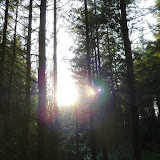This short Sunday morning stroll was to take us through the “Fisher’s Field Nature Reserve”. Originally this field was a grazing area for a local farmer, but during the Second World War the field was cultivated for use to grow food. It is now a local nature reserve, and there are places to sit and relax, walk and and place for wildlife to thrive! It is certainly nice to know that this particular reserve was submitted for a green flag award during 2012 🙂
The path we were to follow, suggested we were going to the “The Otter”. This seemed like a lovely end goal, since I was assured that “The Otter” is a pub! As we made our way through the reserve, which despite not being that large was still a lovely walk and made a great morning stroll! When the path came to an end, we had to make a decision as to go left or right, as unfortunately there are no signs at this point 😦 .
We decided to head towards the Golf Course. Sadly, the path is not very well marked over the course, and despite asking someone and our frantic attempts at looking around we could not see the path at all! This was in stark contrast to our experience at the Moor Park Golf Course which had amazing signposts!
 |
| From 2012 – 20.05.2012 – Fishers Nature Reserve – Bushey Mill Lane Walk |
We made a joint decision and returned to the footpath. The path took us past some houses and out onto the road known as “Park Avenue”. It was quite frustrating to walk along the road, as we could see the Golf Course behind all the houses and what we believed to be the footpath as well. Unfortunately as we continued along there were no obvious footpath signs off the road. Although I did suggest nipping through someones back garden and over their fence, this did not happen I hasten to add !!
It was not long before we reached the end of Park Avenue and arrived at “Bushey Mill Lane”. As we looked around, we discovered the sign / entrance to the public footpath which was back to Fishers Field! The odd thing about the destination of this public footpath, was where was “The Otter” pub? Unfortunately the footpath signs have not been updated, as the pub is no longer there and some houses have since been built on the site 😦 So sadly there was no chance of a drink! So we decided to take the path back to the reserve.
As we started to walk along the path, I noticed that it ran alongside a stream. I wondered if this stream, had at one point a mill built alongside it? Particularly as we had just come from “Bushey Mill Lane”. It seems that this area was part of a large estate known as”Bushey Hall”. I cannot find out much about the mill, whether it was responsible for producing paper or flour, but from the size of the stream, I can’t imagine that it would have been on a grand scale? However, from the history of Bushey Hall, which at one time was an exclusive hotel during the 1880’s with many Hydrotherapy treatments, I am sure that the stream must have been adequate for for their needs too! Although I would need to read much more about it 🙂
 |
| From 2012 – 20.05.2012 – Fishers Nature Reserve – Bushey Mill Lane Walk |
The footpath was narrow to follow, but it was still pleasant enough to walk along. On the other side of the stream was the Bushey Hall Golf Club, therefore it was not unexpected to find numerous lost golf balls in the stream! On one occasion the path seem to be walking through some woods rather than just past the golf course and stream. The trees were quite dense and it really did feel like a really lovely woodland walk.
It was almost a shame when the path suddenly seem to come to an end, when it reached a bridge to cross the little river. The bridge was to take us out into the Golf Course. Frustratingly for both of us, we spotted where we had been standing, at the beginning of our walk looking for this particular path to the Otter! As we crossed the course to the other path and looked across we were both confused why we did not see the bridge in the first place!
The little wooded copse, where the footpath goes through, in the course is actually “Scotts Wood”. Although I am unable to locate much information about the origins of Scotts Wood, I have learned that there is a theory that the name “Bushey” is derived from the Old English word “bysce” and Old French boisseie, meaning a “place covered with wood”. It certainly makes sense that Bushey earned it’s name that way! We followed the path back into Fishers Field, where we finished our short walk so we could adjourn for our Sunday Lunch… 🙂
For the morning’s photos, please feel free to scroll through them by clicking the photo below –
 |
| 2012 – 20.05.2012 – Fishers Nature Reserve – Bushey Mill Lane Walk |
<><



